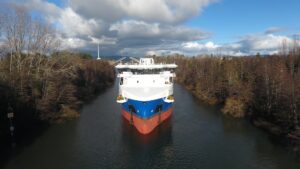Big fish carrier makes maiden voyage

The largest fish transport ship ever built in Chile, the world’s second largest salmon farming country, has set sail for the first time.
The Patagon X1 is also the largest fish carrier in both North and Latin America.
Manufactured by the ASENAV national shipyard in Valdivia, it measures 79.80 metres long overall, a width of 17.20 metres, and reaches up to 26.6 metres in height. The management of the operation says this was vital so that the ship could pass under a tilting structure of the Caucau bridge on the way out.
Heinz Pierce, general manager of ASENAV, highlighted the importance of the ship going out into the open sea.
He said: “With the Patagon XI setting sail, we are giving a concrete signal that this Live Fish Carrier, built entirely in Chile, establishes us as a country as a benchmark and at the forefront of the shipbuilding industry and maritime solutions in general at an international level.
He added: “Undoubtedly, its navigation under the Caucau Bridge implies that we can address different challenges, which is why we are proud to promote Chilean engineering and be a contribution as one of the most relevant shipyards on the Pacific Coast and the Caribbean.”

Jesús Grandón, head of Ship Inspection of the General Directorate of the Maritime Territory and Merchant Marine of Chile indicated that although the vessel will operate in national waters, from the city of Puerto Montt to the south, “it could transit to another country”.
Ricardo Contreras, the ASENAV project engineer, highlighted the technical details of the Patagon XI with its innovative system for loading and unloading live fish, oxygenation of the species, and water treatment systems in the sectors in the ship operational regions.
He said: “This vessel has a large cargo capacity of up to 400 tons of live fish, representing an advantage for the salmon industry, with fewer trips between a farm and harvest centers.
“The Patagon XI also has a CO2 treatment system and UV reactors to eliminate infections that the fish might have when getting into the vessel. In this way, clean water is returned to the sea, making this ship more environmentally friendly.”
Contreras explained that the vessel also has a particular method of “dry” loading and unloading live fish in that after collecting the fish from the cages in the sea, it separates them from the water and enters them into a hold-pond that contains seawater in ideal conditions to receive them and keep them in good condition during transport.

